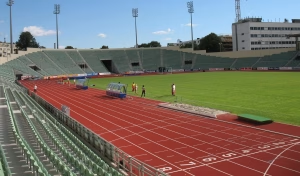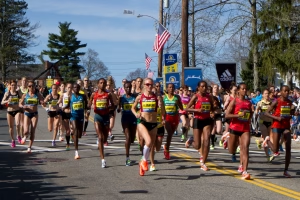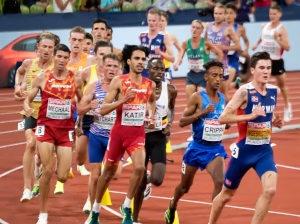This article is about the physiological thresholds below VO2 max that highly predict distance running performance.
Distance runners should train to optimize their VO2 max, but there is another important intensity, often called the anaerobic threshold, that sits between your easy pace and your VO2 max pace. It is helpful to know where this intensity is for you, so you can optimize your training for your individual physiology. You can find a more detailed discussion of VO2 max in this article [link].
If VO2 max represents the white-hot burn at the limit of aerobic performance (such as in the middle distance races of 800 m to 3000 m), there are also metabolic factors at a lower intensity that represent the relatively slow-burning endurance for long distances (such as 5000 m to the marathon).
Anaerobic threshold was perhaps the first term applied to this intensity zone, but we will refine this and provide a more elaborate description.
Runners also have a lingo to describe the training pace associated with this physiological intensity, usually the word tempo, or simply threshold run.
Other physiological terms associated with anaerobic threshold are mostly associated with blood lactate, although ventilatory threshold is also sometimes mentioned. Ventilatory threshold refers to the increasingly rapid changes in breathing variables such as oxygen intake and carbon dioxide production.
We will focus on blood lactate because it has received the most attention in the scientific literature pertaining to training and performance.
Terms associated with blood lactate include lactate threshold, onset of blood lactate accumulation, and maximal lactate steady state.
Blood lactate kinetics per se may not be the only explanation for superior long distance performance, but this is one of the most prominent of many metabolic processes that seem to be accelerated at roughly the same exercise intensity.
Thus, it is a very good signal that some major metabolic changes are happening. Once you know where that occurs for you, you can use that information to plan your training.
Is lactate the same as lactic acid?
Your body doesn’t make lactic acid. Only lactate is present in your blood. You might see the term lactic acid being used, even in the scientific literature or other in-depth articles on physiology and endurance training. But usually, you can just substitute the term lactate and continue reading as before.
We will explain two key measurements that can be done with lactate. One is the lactate threshold (sometimes abbreviated LT) and the other is maximal lactate steady state (sometimes abbreviated MLSS).
Blood lactate curve
The blood lactate curve is used to identify two thresholds known as the aerobic threshold and the anaerobic threshold. The anaerobic threshold is sometimes defined as the lactate threshold, so we will use those terms interchangeably.
To find the lactate curve, you need to perform a graded exercise test. This involves running faster and faster each stage of the test and blood lactate concentrations are measured at the end of each stage. We can see an example lactate curve in the figure below.
Aerobic threshold
When you first increase running speed from rest, blood lactate doesn’t immediately rise. At the slowest of speeds (green zone), blood lactate stays the same, even though the speed has increased from 10-11 km/h.
If you keep increasing the running speed, you get to the aerobic threshold. This occurs when blood lactate rises above its baseline value. In the graph above, you can see a slight increase once the runner hits 12 km/h, where the lactate value rises from 1.5 to 1.75 mmol/L. These values are just examples and might vary between individuals.
Below the aerobic threshold is a low-intensity zone best suited for recovery or easy training. Within this zone, almost all of your energy is supplied by aerobic pathways. And there is potential to continue at this pace for hours (reference).
Anaerobic threshold & lactate threshold
The anaerobic threshold is often defined by the lactate threshold, although definitions have varied over the history of modern exercise physiology. This intensity is highly correlated with endurance performance.
Lactate threshold itself has numerous descriptions and can be overwhelming. In fact, one scientific article described 25 different associated concepts. Exercise physiologists have different ideas on how to best identify when lactate kinetics start behaving differently – that’s the reason for so many methods.
Fortunately, it is not important to know all of these methods. For runners, it is sufficient to understand that with increasing intensity, there is a level at which physiological processes tend to accelerate.
The lactate threshold is basically identified when its relationship with speed becomes much steeper. You can think of it as an “elbow” in the graph, although it is not always so easy to identify on the curve. But there is another method of analyzing blood lactate called the maximal lactate steady state that doesn’t require such mathematical modeling.
Maximal lactate steady state (MLSS)
The lactate threshold is determined by examining changes in lactate at different running speeds. In contrast, the maximal lactate steady state (MLSS) is shown by measuring changes in lactate over time for each running speed. MLSS the highest speed you can maintain continuously without the lactate level increasing over time.
This means that any faster speed will cause the lactate levels to increase over time, and with that comes a more rapid development of fatigue. MLSS also is highly correlated with endurance performance.
Different running speeds with their own lactate curves (plateau or increasing) are shown in the graph below.
The graph above helps us understand blood lactate response to constant running at different speeds. The values correspond with the example in the previous figure, so we might assume this is the same hypothetical runner.
- 10 km/h is below the aerobic threshold, so lactate doesn’t rise above baseline.
- 12 km/h is at the aerobic threshold, so it is fast enough that lactate rises above baseline.
- 14 km/h is also above the aerobic threshold, with lactate above baseline.
- 16 km/h is at MLSS, so it is the fastest speed that still shows a plateau in lactate. This speed might be maintained for 60 minutes in this example.
- 17 km/h is above MLSS, so lactate never plateaus. The athlete can only maintain for 40 minutes.
- 18 km/h is also above MLSS, so lactate never plateaus and rises even faster than above. The athlete can only maintain for 30 minutes.
Aerobic-anaerobic transition zone
The aerobic-anaerobic transition zone is the range between the aerobic and anaerobic threshold. This is the zone of moderate to high intensity endurance training. Intensities close to (but not above) the MLSS are especially important. Many athletes are able to maintain this pace for 45-60 minutes.
Above the MLSS
When running continuously above this intensity zone, you have discomfort that consistently increases throughout the entire run. At this intensity, the first several minutes might even feel quite comfortable, but there is a gradual, but constant increase in the burning in your leg muscles, rapid breathing, and an increasing general desire to slow down or stop.
The reason for this increasing discomfort is that above such an intensity, your physiology can no longer operate at a steady-state, where things remain constant for long periods of time. Instead, your physiological systems cannot keep up to maintain constant internal conditions, so you slowly progress toward inevitable exhaustion.
Runners who train seriously know what feelings accompany this intensity.
Marius Bakken, a former world-class 5000 m runner from Norway believes that Kenyan runners have a natural feeling for this intensity, perhaps because they are altitude natives and altitude allows you to feel these sensations more acutely. Marius Bakken’s writings can be found here, and he has a particular interest in lactate training.
If you would like to learn more about the Norwegian method of lactate threshold training here is a focused article. I have also written about the approach of Jakob Ingebrigtsen (pictured below at right)
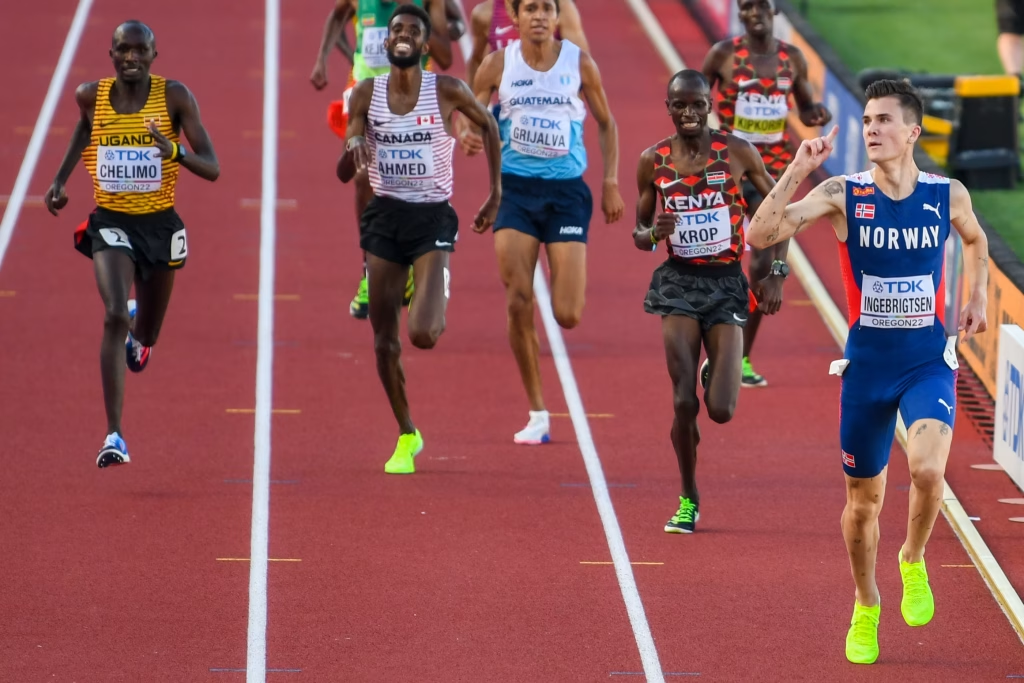
Often, your own prediction of this progression is an important part of pacing strategy – you need to understand how you feel at the beginning of a race and then go only so fast as you feel you can continue to the very end.
If you get this wrong and go even a little bit too fast at the beginning, the progression of fatigue will be too steep and you will never make it to the end, or else you will need to slow down.
This training zone is typically approached using intervals. This breaks up the duration to allow for the accumulation of distance at a given pace longer than would normally be possible.
Lactate threshold testing protocol
It is more convenient to test and lactate threshold because it can be done in a single exercise test of reasonable length. However, a lactate threshold test is longer than a VO2 max test because the stages need to be longer. For example 5 minute stages might be used to give the blood lactate levels time to increase after the physiology adjusts to each running speed.
In contrast to VO2 max max testing, which requires elaborate laboratory equipment, blood lactate is analyzed using a small digital device. After each running stage the tester will use a small lancet to prick your finger tip or earlobe to get a drop of blood. This blood will be applied to the end of a special testing stick that is then inserted into the device.
This method is similar to how diabetics test their blood sugar (although the device and testing sticks provide a different chemical test).
After each drop of blood After about 15 seconds, the lactate meter will output the value, which will be recorded by the testing staff. Once you can’t continue any longer, the test will end. The study staff may take a bit of time to analyze the lactate data, but you probably won’t need to wait too long to get your results.
These results should include the different running speeds and the associated blood lactate values. It would also be helpful to have the corresponding heart rate as well, so you can define your intensity zones by heart rate as well.
MLSS testing protocol
Maximal lactate steady state testing requires a more elaborate protocol. Unfortunately, the best method for determination involves several trials of continuous running at different speeds for at least 30 minutes. This would need to be spread over multiple days.
For every increment of speed, you are basically looking for whether blood lactate increases from the 10th minute to the 30th minute of continuous running. In this case, an increase of less than 1.0 mmol/L would be considered to be steady state. Any running speed that leads to an increase of more than 1.0 mmol/L from minute 10 to 30 is above is considered to be above the MLSS.
You will want to choose speeds between 50 and 90% of your VO2 max. Further information on VO2 max and ways to estimate it are [here] and [here].
Where can I get a lactate test?
Unless you are an elite athlete in a professional or national program, the most common place to get a lactate test is a university laboratory or a medical system that has a sports performance program.
University departments are sometimes named differently depending on where you are in the world. You might try searching for “sport science”, “exercise physiology’, “kinesiology”, or “human kinetics”.
Can I conduct a lactate test myself?
Yes, it is possible to purchase a lactate meter, which might cost about 300 dollars. Remember to factor in the cost of the test strips as you assess your budget. Test strips might cost about 50 dollars for a pack of 25, which amounts to about $2 per test.
How to estimate MLSS
Given the inconvenience of multi-day run trials and the requirement for getting a drop of blood for each test, the desire for a method to estimate MLSS is understandable. Fortunately, there is some guidance in the sport science literature.
A research group from the University of Kansas reviewed the literature on heart rate, breathing rate, and rating of perceived exertion, and how those variables may be used to predict MLSS. The suggested values were a heart rate of 87% of maximum, a breathing rate of 32 breaths per minute, and a rating of perceived exertion of 12 on the 6-20 Borg scale (corresponding with a verbal anchor of between “light” and “somewhat hard”).
In my opinion, it would be reasonable to see at what speed each of those values corresponds with and perhaps take the average speed as the best estimate of MLSS.
A model of distance running performance
Here is how blood lactate and the associated larger concept of anaerobic fits with other metrics of endurance fitness. Our model of distance running performance includes 3 key concepts:
- VO2 max
- Anaerobic threshold
- Running economy
VO2 max and anaerobic threshold represent the body’s physiological capacity – this is the supply-side of the equation. Running economy, on the other hand, refers to the metabolic cost of movement that must be supplied by the energy system.
We will discuss more about running economy in a separate article, but for now, the better running economy is, the less you need from the energy supply system at any given speed, and potentially farther away from the limits imposed by VO2 max and lactate threshold.
Of course, you want to increase both VO2 max and lactate threshold as high as possible. The two variables are not independent. If you increase your VO2 max, you tend to bring up the lactate threshold with it, as the lactate threshold is often expressed as a percentage of VO2 max.
Relationship to race performance
The anaerobic threshold is highly correlated to endurance race performance. The relationship strengthens in the longer distance events, according to a literature review.
For instance, the anaerobic threshold as defined as lactate threshold had a correlation of 0.88 with middle distance performances (800 m to 3200 m). The median correlation increased to 0.91 for longer distances ranging from 5000 m to the marathon.
How can I do lactate threshold training?
Marius Bakken has written on his experiences and insights on lactate training. He believes that focused training at the lactate threshold instead of a race pace that is faster may be a better choice, even though it is not as specific as that race pace. His given reason is that this slightly lower intensity, when accumulated, requires less recovery and is overall more beneficial than more intense running.
I think this reasoning is also held by Jacob Ingebrigtsen (a current world class Norwegian distance runner), according to Alex Hutchinson, writing in Outside Online. I am intrigued by this concept and hope to write more in-depth on this soon.
Lactate workouts
Bakken reports correspondence from Norwegian triathlon coach Arild Tveiten suggesting sample workout of 6*2000 m at a pace below MLSS, or at least at a stable lactate measured at the end of every interval.
Other lactate training options Bakken suggests are 4-5*10 minutes or 7*6 minutes. These both would accumulate 40-50 minutes at just below MLSS speed, which is within the recommended accumulation of 36-60 minutes for the entire training session.
For these workouts, I would add that a treadmill can be a useful tool in the whole learning process because it allows you tightly control the speed and other workout conditions.
Bakken cautions that continuous work at speeds close to the MLSS can cause increased stress on the muscles, which can impair recovery, although he acknowledges that for marathon training, continuous work is probably necessary.
Summary
The general concept of anaerobic threshold and the associated metrics involving blood lactate concentration is highly correlated to distance running performance, especially those race distances above 3000 m. Although comprehensive lactate testing is not always convenient, the cost of a lactate meter is reasonable and possible for runners without access to an exercise physiology lab. Training just below MLSS may enhance distance running performance without the musculoskeletal stress associated with higher intensities. The MLSS can thus help runners of all levels dial-in their intensity zones for optimal training.
Are you a regular (non-elite) runner who has tried lactate testing and training? Let us know of your experiences in the comments down below!

